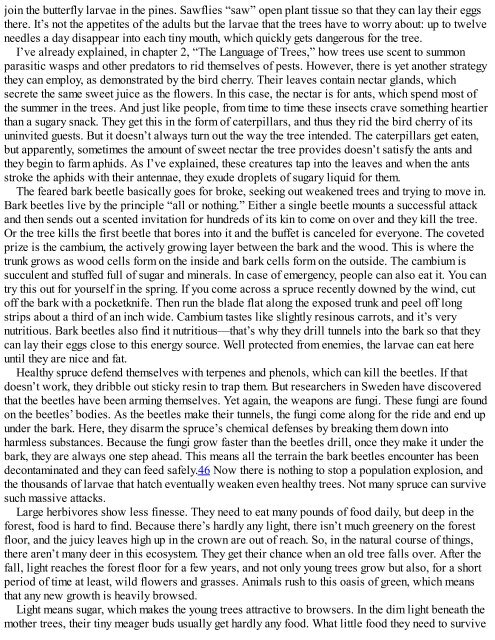Create successful ePaper yourself
Turn your PDF publications into a flip-book with our unique Google optimized e-Paper software.
join the butterfly larvae in the pines. Sawflies “saw” open plant tissue so that they can lay their eggs<br />
there. It’s not the appetites <strong>of</strong> the adults but the larvae that the trees have to worry about: up to twelve<br />
needles a day disappear into each tiny mouth, which quickly gets dangerous for the tree.<br />
I’ve already explained, in chapter 2, “<strong>The</strong> Language <strong>of</strong> <strong>Trees</strong>,” how trees use scent to summon<br />
parasitic wasps and other predators to rid themselves <strong>of</strong> pests. <strong>How</strong>ever, there is yet another strategy<br />
they can employ, as demonstrated by the bird cherry. <strong>The</strong>ir leaves contain nectar glands, which<br />
secrete the same sweet juice as the flowers. In this case, the nectar is for ants, which spend most <strong>of</strong><br />
the summer in the trees. And just like people, from time to time these insects crave something heartier<br />
than a sugary snack. <strong>The</strong>y get this in the form <strong>of</strong> caterpillars, and thus they rid the bird cherry <strong>of</strong> its<br />
uninvited guests. But it doesn’t always turn out the way the tree intended. <strong>The</strong> caterpillars get eaten,<br />
but apparently, sometimes the amount <strong>of</strong> sweet nectar the tree provides doesn’t satisfy the ants and<br />
they begin to farm aphids. As I’ve explained, these creatures tap into the leaves and when the ants<br />
stroke the aphids with their antennae, they exude droplets <strong>of</strong> sugary liquid for them.<br />
<strong>The</strong> feared bark beetle basically goes for broke, seeking out weakened trees and trying to move in.<br />
Bark beetles live by the principle “all or nothing.” Either a single beetle mounts a successful attack<br />
and then sends out a scented invitation for hundreds <strong>of</strong> its kin to come on over and they kill the tree.<br />
Or the tree kills the first beetle that bores into it and the buffet is canceled for everyone. <strong>The</strong> coveted<br />
prize is the cambium, the actively growing layer between the bark and the wood. This is where the<br />
trunk grows as wood cells form on the inside and bark cells form on the outside. <strong>The</strong> cambium is<br />
succulent and stuffed full <strong>of</strong> sugar and minerals. In case <strong>of</strong> emergency, people can also eat it. You can<br />
try this out for yourself in the spring. If you come across a spruce recently downed by the wind, cut<br />
<strong>of</strong>f the bark with a pocketknife. <strong>The</strong>n run the blade flat along the exposed trunk and peel <strong>of</strong>f long<br />
strips about a third <strong>of</strong> an inch wide. Cambium tastes like slightly resinous carrots, and it’s very<br />
nutritious. Bark beetles also find it nutritious—that’s why they drill tunnels into the bark so that they<br />
can lay their eggs close to this energy source. Well protected from enemies, the larvae can eat here<br />
until they are nice and fat.<br />
Healthy spruce defend themselves with terpenes and phenols, which can kill the beetles. If that<br />
doesn’t work, they dribble out sticky resin to trap them. But researchers in Sweden have discovered<br />
that the beetles have been arming themselves. Yet again, the weapons are fungi. <strong>The</strong>se fungi are found<br />
on the beetles’ bodies. As the beetles make their tunnels, the fungi come along for the ride and end up<br />
under the bark. Here, they disarm the spruce’s chemical defenses by breaking them down into<br />
harmless substances. Because the fungi grow faster than the beetles drill, once they make it under the<br />
bark, they are always one step ahead. This means all the terrain the bark beetles encounter has been<br />
decontaminated and they can feed safely.46 Now there is nothing to stop a population explosion, and<br />
the thousands <strong>of</strong> larvae that hatch eventually weaken even healthy trees. Not many spruce can survive<br />
such massive attacks.<br />
Large herbivores show less finesse. <strong>The</strong>y need to eat many pounds <strong>of</strong> food daily, but deep in the<br />
forest, food is hard to find. Because there’s hardly any light, there isn’t much greenery on the forest<br />
floor, and the juicy leaves high up in the crown are out <strong>of</strong> reach. So, in the natural course <strong>of</strong> things,<br />
there aren’t many deer in this ecosystem. <strong>The</strong>y get their chance when an old tree falls over. After the<br />
fall, light reaches the forest floor for a few years, and not only young trees grow but also, for a short<br />
period <strong>of</strong> time at least, wild flowers and grasses. Animals rush to this oasis <strong>of</strong> green, which means<br />
that any new growth is heavily browsed.<br />
Light means sugar, which makes the young trees attractive to browsers. In the dim light beneath the<br />
mother trees, their tiny meager buds usually get hardly any food. <strong>What</strong> little food they need to survive
















